Welcome to Moda Fabrics!
Jen Kingwell ~ Tempters & Templates
Jen Kingwell ~ Tempters & Templates
There was a time when rotary cutters were a relatively new tool, when there weren't rulers that made easy work of cutting strips, squares and triangles. Quilt blocks were frequently made by marking or tracing lines on a piece of plastic, and then using scissors to cut a template that was used to cut that shape from fabric.
That might explain why so many of my early quilts were Irish Chains, Trip Around the World, log cabins and even Lone Stars. The cutting was so much easier, and faster. (And Blanche and Helen Young were prolific authors with really good books.)
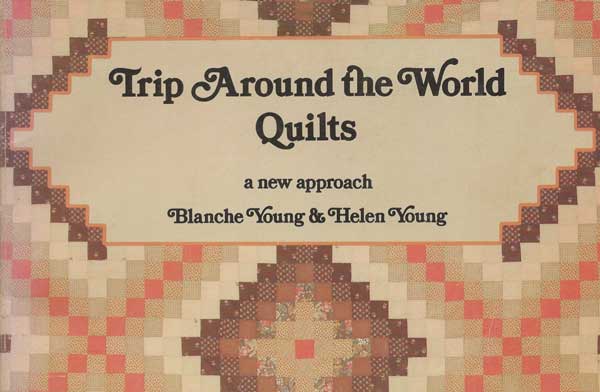
Circa 1982?
For all the many good things that came out of these new tools, I think a few things were lost. Speed, and how many quilts we could make in a month, seemed to take precedence over "slow-stitching", the quiet enjoyment of making something by hand. A complicated block became one with more than twenty pieces, and "bias" became something to avoid at all costs.
Then Jen Kingwell showed up. With gorgeous, complicated quilts. (What a friend loved to call "worthy quilts.")
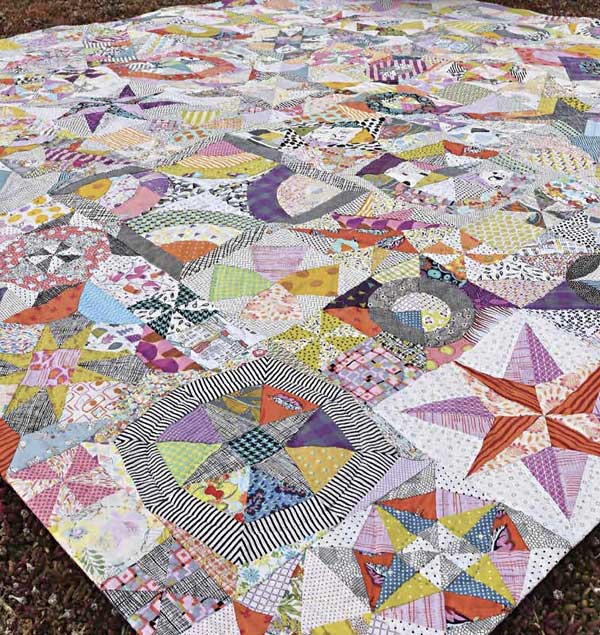
Jen's Delilah quilt - Booklet (JKD 5552) and Template Set (JKD 5835)
She made quilts with super-cool, vintage-looking blocks that were best made using templates.
Fortunately, she helped with that.
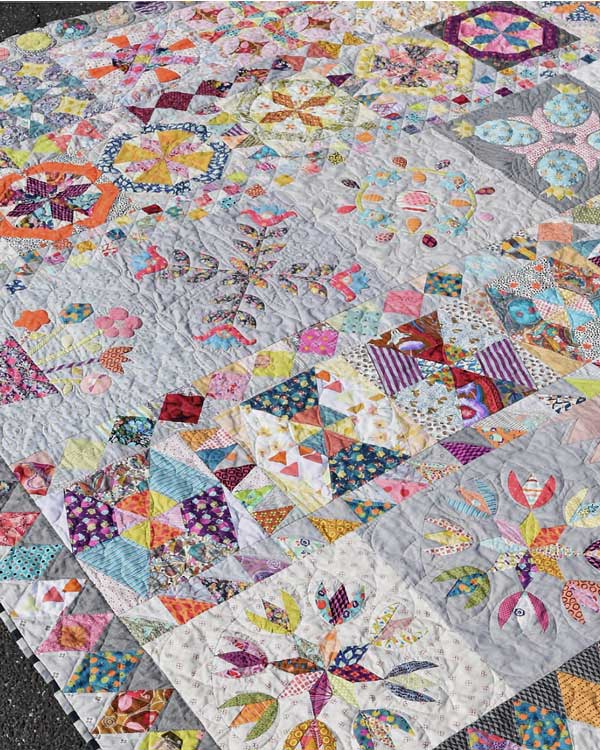
Jen's Golden Days - pattern booklet (JKD 8274) and Template Set (JKD 8342).
In some circles, templates got a bad name. Too time-consuming, too much trouble, and, okay, too expensive to make just one quilt. Except that the purpose of any tool is to help get better results. The better the results, the more I will enjoy the process. It's like trimming half-triangle squares and flying geese to size - I am happy to spend that extra time, and waste a bit of fabric, if it means my blocks and quilt top are flat, square and the points aren't all chopped off.
We won't even talk about the design possibilities - fussy-cutting? - that templates allow.
A tumbler quilt was my foray back into templates, and then I fell in love with Jen's quilts. And her templates.
So let's talk templates, Tempters, Postcards and tools with Jen.
What lead to the decision to start producing/cutting templates for your patterns?
As a hand piecer I love the accuracy of templates, so it really felt like a natural thing to do. Much like the production of Quilt Recipes, I wanted to keep it onshore and employ someone from the local area to cut my templates.
I'm curious if this grew out of Steam Punk. When that quilt "exploded" across the quiltosphere, everybody wanted templates to make cutting easier. Were you already doing them? Or is that what led you to investigate this as an option?
You're right. That was the first quilt we cut templates for, and we outsourced that production to another company as it all happened quite quickly.
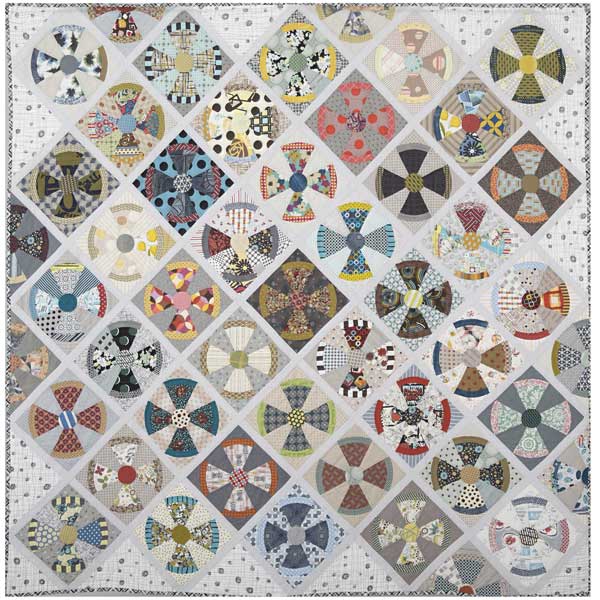
Steam Punk - Pattern (JKD 5095) and Template Set (JKD 5903).
When you started offering templates for your other patterns, were you cutting them yourself?
Yes. As we started to develop more of my patterns and other shops wanted to order templates, it made sense to cut out the middle-man and cut the templates ourselves. It keeps the cost low for our customers while still manufacturing locally, and in Australia.
Orange? I love the color but was there a reason for choosing that color?
Orange! My favourite colour! The first option was clear, but I can never find them among my very "creatively organised" stash.
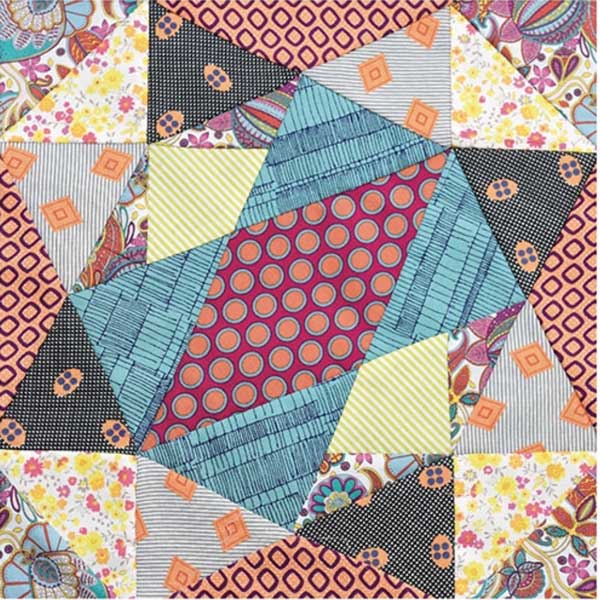
Airey's Tempter - JKD 5392 - 12" Finished Block (12½" unfinished.)
How important was it to you to have something that was immediately recognizable as "Jen Kingwell"? (It's genius, of course, but I'm curious about your thought process here.)
Although they have become recognizable, the real reason was I wanted a bright/standout colour that was still see-through, and it was not used being by any other company.
Was there a big learning curve with the cutting machine?
Yes! We had to learn a whole new program to run it, it's all done on the computer. And like all machinery, it can be temperamental on any given day. There is a lot of troubleshooting that goes on daily!
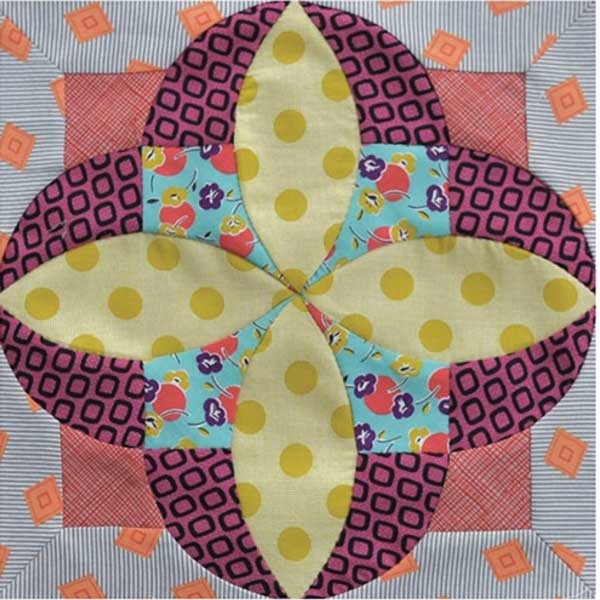
Tempters Tilly - JKD 5347. Block finishes at 10" - unfinished at 10½".
Did your Postcards really grow out of finding ways to use the unused portions of the template sheet?
Absolutely. However they have become a beast of their own and we actually cut them as well as when filling in space.
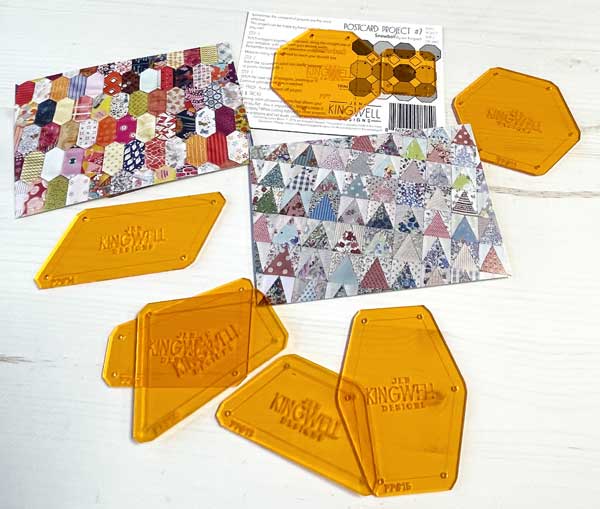
Acrylic? Plastic? What kinds of things did you have to consider when deciding what kind of material to use, and what thickness?
The beauty of acrylic templates is they are user-friendly if you cut by hand, and if you use a rotary cutter. I use them for hand-piecing more than anything else as they make my life so much easier but I understand a lot of people (crazy people!) prefer machine-piecing, so we wanted to cover all bases.
What has been the biggest challenge with doing templates?
Supply and demand. There are a lot of moving parts to this facet of the business, maybe more than we anticipated when starting this journey.
Ensuring we have enough acrylic to cut, but not so much that it takes up too much space. (Which you already know I like to fill.) We also have to have the right amount of paperwork and supplies to cover orders, the cleaning products, glue, stickers, and staff! It may sound silly but it's quite the operation, and you have to make sure you're always planning ahead, while remaining flexible enough to pivot to ensure it can all run smoothly.
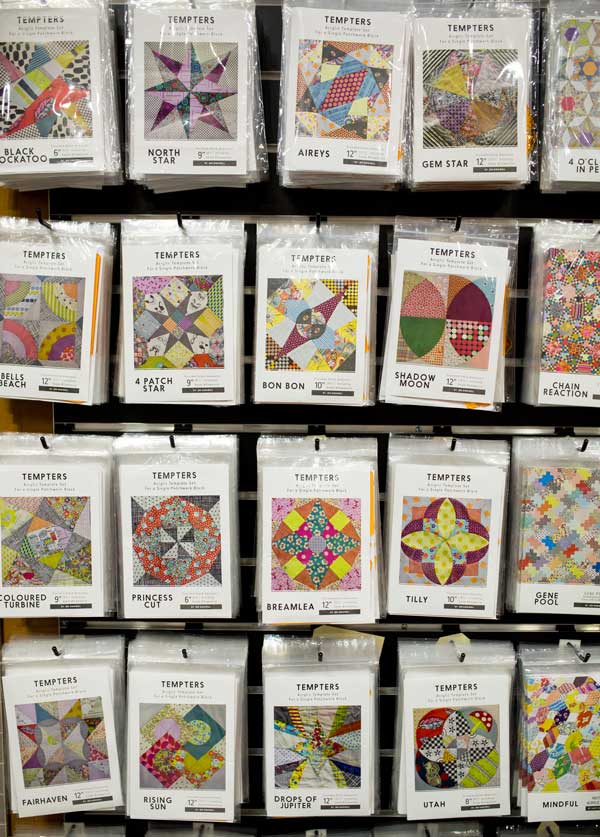
Has there been any part of it that was easier than you expected?
No. (Laughs.)
Best-selling template or Tempter?
I would say Halo from the Jen From One Block pattern booklet has been the best Tempter. Although since the release of Qulit Recipes, Wensleydale is quickly catching up!
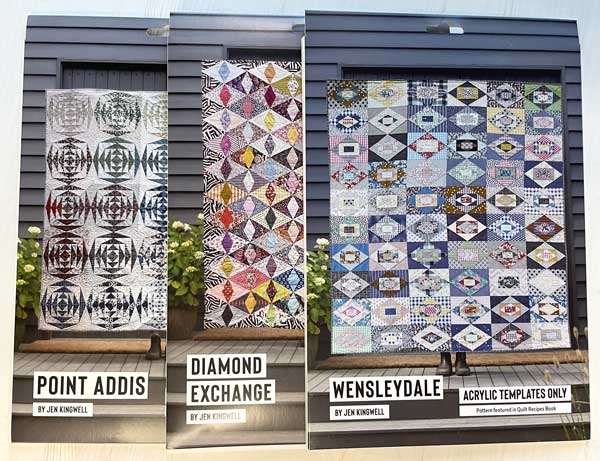
From left to right: Point Addis - JKD 8748. Diamond Exchange - JKD 8731. Wensleydale - JKD 8724. All three of these quilts are in Jen's glorious new book, Quilt Recipes - JKD 8717.
When you create the templates for a quilt - something like Psychedelia - are you already envisioning how some of them can be used for a one-block quilt? E.g., Nancy. What about different combinations?
The Psychedelia idea actually started as a cushion of the month program... then I thought "how many cushions does one person need?"
I dream about the day that I will have time to do more "hacks" of what people can do with a specific template set.
When I designed the Nancy block, I absolutely loved it, and wanted it to become part of the Tempter range. As soon as I saw the sample yardage of The Lookout, I knew Nancy would be perfect to sample this up in. I love the result! It's very different to everything else in the range.
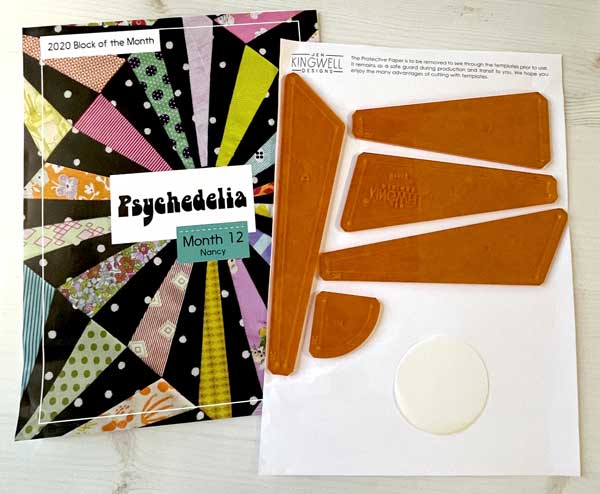
Nancy - JKD 8830. (This is the template that was part of Jen's 2020 Psychedelia Block of the Month.)
Tell me how you use your templates. (E.g., do you trace them and cut them out with scissors? ACK!) If you do that, do you use your Sand Paper Board for tracing?
Yes and yes. Call me crazy - as you have many times in the past over this - but I do trace on my sand paper board then I cut it out with scissors.
You have to understand, I'm a country kid who never got to go to kindergarden and play with scissors so I'm reliving my youth! And honestly, I find rotary cutting unbelievably boring. Isn't it fantastic that we can all love "quilting", and we can enjoy such different techniques and parts of the process.
Scissors - big or small? (Or whatever is within reach?)
Medium! haha I love Karen Kay Buckley scissors and I use the blue handle. I think they're the 6" size in the US. They're just the perfect size for cutting, and I love the serrrated edge on the blades. It holds the fabric while cutting, and they cut so, so accurately.
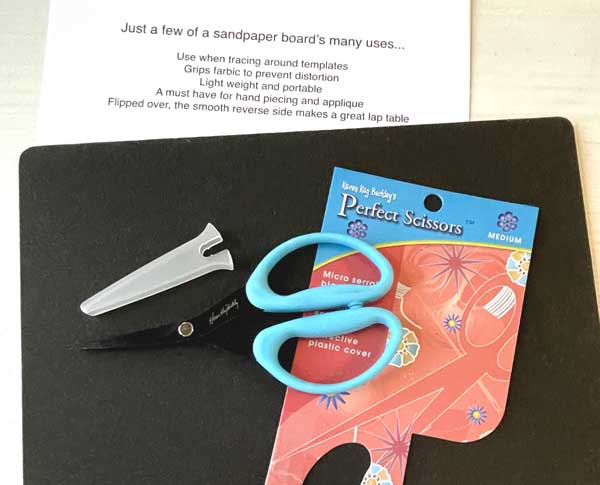
Jen's Sand Paper Board - JKD 8366. Karen Kay Buckley Perfect Scissors Medium Size - KKB 004.
Do you use a marking pencil or chalk? If so, what kind?
I use a mechanical pencil with a #2 lead, it's a 2B here in Australia. It's soft, and it transfers easily. It also erases easily.
A regular pencil also works, but the mechanical is so good because it fits easily through the registration points on the templates, and the lines are fine and consistent. Any brand or type is fine, it's more about the soft lead.
Registration points?
The tiny holes that hand-piecers use for matching points. (Laughs again.)
(Still laughing.)
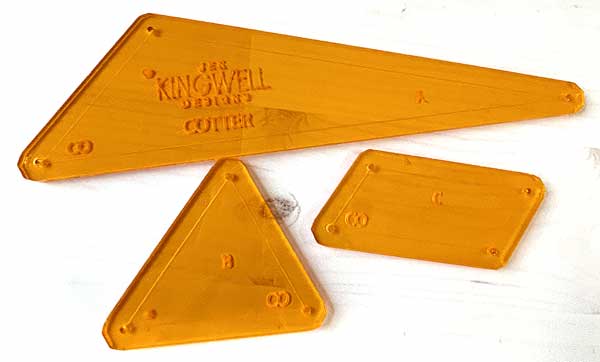
All of the templates have the registration points - holes - at the intersection of the ¼" seam allowance.
Your friend, Sue Spargo, had a "creative class" post the other day about her favorite marking tools for wool, and one of the items she mentioned was Sewline's Marking Pencil Trio. It has three colors, and it's more of a "chalk" kind of lead, than actual lead. Have you used anything like that?
I do use Sewline pencils in either white or pink if I'm marking dark fabrics. I'm not so keen on the trio as I don't like the thickness of the pencil in my hand. But it's a great choice, especially if it's something you already have on hand.
Do you worry about the grain of the fabric - or is the print and direction the primary focus?
For me, being a hand piecer, the print and direction is the primary focus. I seriously don't worry about grainline except when stitching curves.
I am far more focused on fussy cutting a stripe or an image than I am with a grainline, and I have so much control over the stretch with my needle and thread that this is rarely a problem.
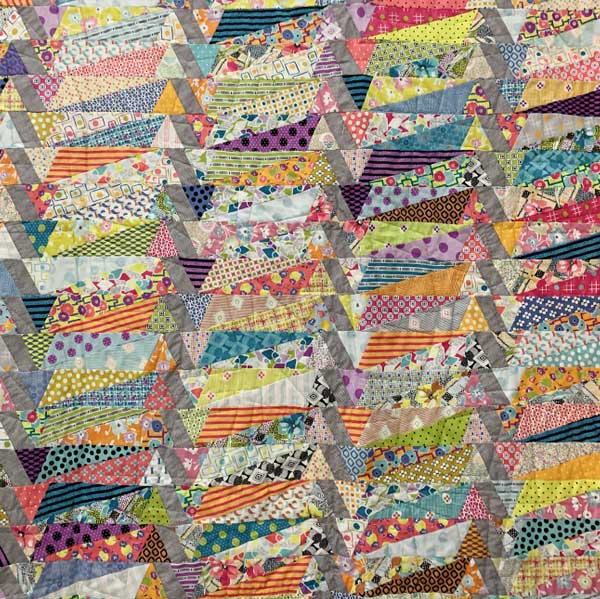
Like many of the Tempter blocks, Cotter is a single-block template that only has instructions on how to complete the block. It doesn't have a separate pattern, or come from a book, and the quilt can be made to any size. It's about making a block to add to a sampler quilt, or it can be repeated to make a quilt.
One of the things I love about the Tempters for individual blocks have a coloring diagram on the back cover. Did that come about from requests, or because it was a good way to fill a space?
A little of both. So many of the blocks in the Tempters can create striking secondary patterns with color placement, so this was a good use of the space.
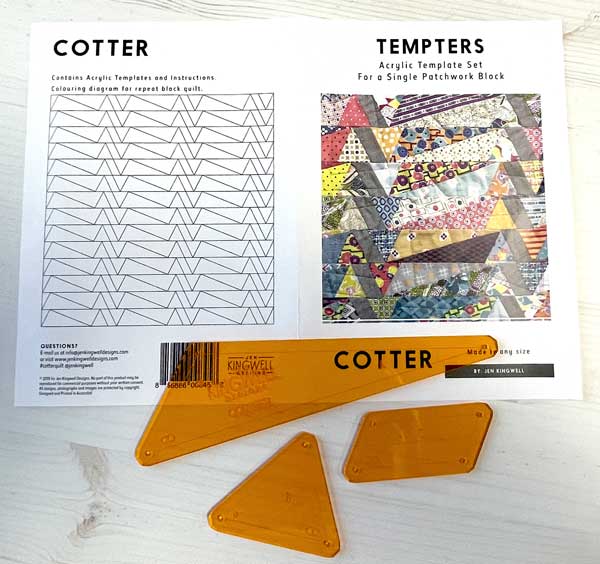
Fabric prep!! Do you do any of that for hand-piecing? Does Flatter help with marking/cutting/stitching the template pieces?
I don't use Flatter for any pre-work except pressing creases out of fabric. But I press my completed blocks with Flatter. It's MAGIC and perfectly named. Bulky seam junctions just flatten beautifully.
Corners and points - are those angled to make it easier to line up?
I never want to have to go back and trim off "doggy ears" so these soft edges are to avoid this extra step.
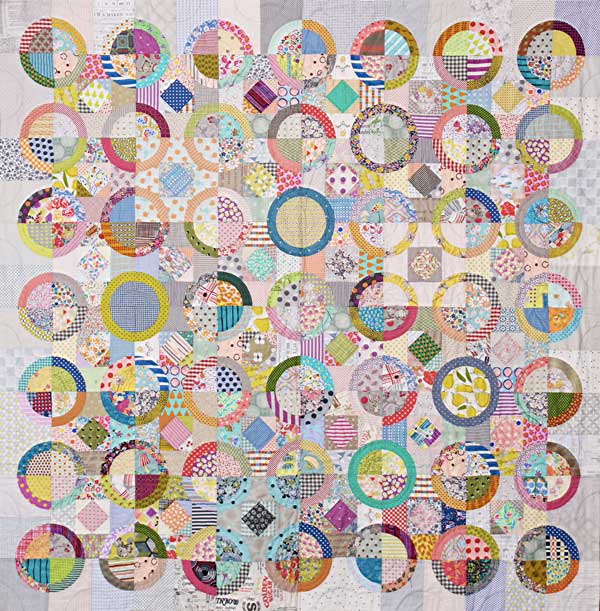
Halo - from the book Jen From One Block (JKD 5262). A template for this quilt block is available - Halo Template JKD 5477.
Trimmed points on the templates - to eliminate "doggy ears", or "dodgy ears"? (I had to read "doggy" twice to be sure... for some reason, the other popped into my head.)
I meant dog ears... what do you call them? Maybe it's an Australian thing?? haha
Do you - or any of the ladies in your shop - use a rotary cutter with the templates, are there any tips to share? (Size of rotary cutter and blade? A ready supply of medical adhesive bandages?)
Haha... you are right, if it's me cutting, then the medical kit needs to be on standby. I do recommend that you use a small cutting mat or a rotating cutting mat and a 28mm blade.
Template Grips! (I love these and use them with every ruler or template.) How did these come about?
I found in classes that a lot of people had problems with their templates moving so I used to cut up little pieces of sandpaper and stick them to the back of their templates. I knew there must be an easier way!
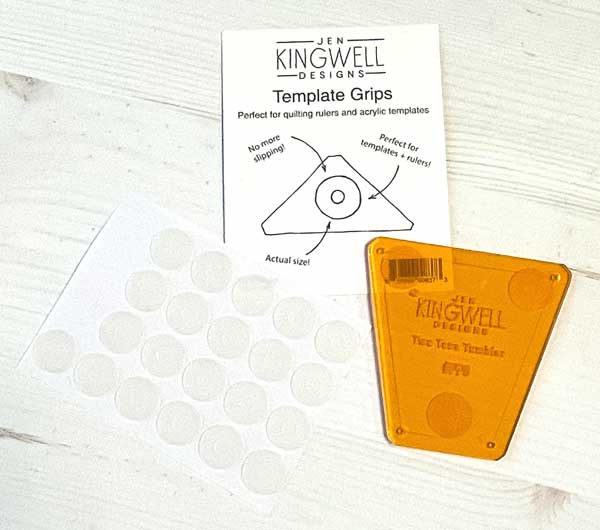
Template Grips - JKD 8373. (I use these on all my rulers and templates - my favorite.)
The packaging for the template sets for Quilt Recipes is different than for your other patterns. Will you be making a change going forward, or is that packaging just for the book?
Before the release of Quilt Recipes we made the decision to change the packaging of all my patterns to reduce our output of single use plastic. While the new look packaging is more expensive to produce, I feel it's up to all of us to do our bit to help the environment in any small way we can. Plus I love the look of it, it really speaks to the direction we are taking the brand in the future.
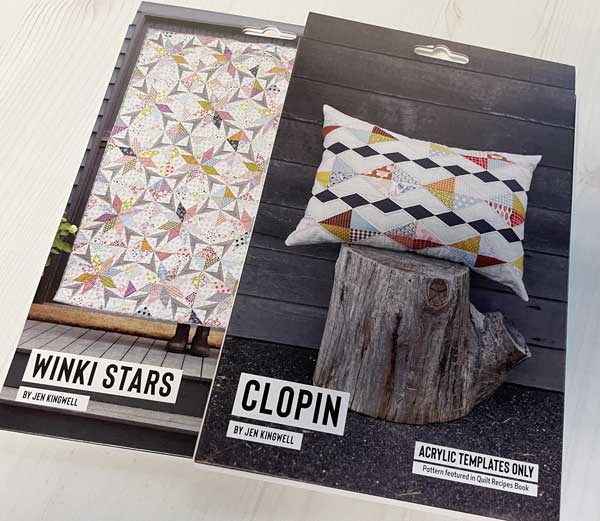
Winki Stars - JKD 8762 and Clopin - JKD JKD 8779 . These are two of the six template sets from Quilt Recipes. (A complete set of all six templates will be available soon - JKD 8793.)
Finally - a design question. Curiosity. Some of the blocks you've created for your quilts are seriously cool, and very different. With your appreciation for design and other arts, are you drawing blocks from shapes and forms you're seeing outside the "quilt world"?
I find inspiration everywhere, so it's really a combination of everything you've mentioned. Sometimes, I just sit down with my notepad and draw, waiting to see what comes out. Sometimes, I see something that sparks an idea. A lot of my quilts have classic blocks in them combined with new designs I create... I love the look of mixing the two.
-----------------------------------------------
So that's it for templates. I will happily confess to not being the easiest of converts, but I'm there. There are quilts and blocks I want to make, and templates are the best way for me to do that. And yes, a couple of those quilts are from Quilt Recipes. (I have a list.)
We're back next week with more questions for Jen about design for fabric and quilts.
What would you ask her?
Stitching. Baking. We hope you get to do one of those this week.
Preferrably with a friend. Or a few.

Comments